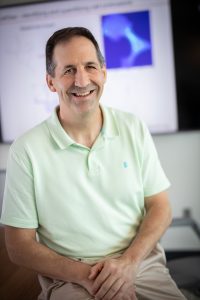UNC Lineberger researchers are betting that computer technology that has made self-driving cars and facial recognition possible could play a role in the next big cancer research discovery.

“It’s the future of medicine,” said UNC Lineberger’s Charles M. Perou, PhD, the May Goldman Shaw Distinguished Professor of Molecular Oncology in the Department of Genetics and Department of Pathology & Laboratory Medicine.
Perou, along with UNC Lineberger’s Tim Elston, PhD, professor in the Department of Pharmacology, is co-director of the new Computational Medicine Program. In this program, the researchers are looking to combine advanced computing and data analysis expertise in order to make discoveries to improve care for an array of diseases, including cancer.
The new program will take advantage of investments that UNC-Chapel Hill has already made in research computing technology. Two strings of computer clusters on campus have the ability to make analyzing large data sets very efficient, Elston said. But Perou said it’s not the hardware that makes the program unique.
“We’re in a revolution; we have the ability to collect huge amounts of data, but now we have to take advantage of it,” Perou said. “The insights just don’t come out of it, you’ve got to develop new mathematical methods to extract the insights.”
On the 11th floor of a newly renovated Mary Ellen Jones building, Perou and Elston are amassing a team of great minds. They recruited two new faculty members and expect to add as many as four more.
Already, researchers have begun their work.
Developing models to predict resistance in cancer
With a five-year, $1.875 million grant from the National Cancer Institute, Perou and Elston are studying whether they can predict resistance in breast cancer. They are studying a particular pathway of signals that can be dysregulated in breast cancer called the RAS-MAP kinase pathway.
“These signals get turned on, and drugs used to treat the cancer work for a while, but these systems are very smart at working around the drugs and becoming resistant,” Elston said. “We’re trying to understand how these tumor cells become resistant and figure out ways to stop that from happening.”
The scientists plan to develop models of how resistance develops by using data from breast cancer samples to develop statistical models.
“We know how to describe all of the biochemistry that goes on in these cells; we can describe all of that mathematically,” Elston said. “What has been lacking is the data to train these models so that you can predict, when you make perturbations to the system (using medications), what’s going to happen.”
Utilizing machine learning in breast cancer research

In another study, Perou and other researchers studied the use of artificial intelligence to analyze breast cancer images. In a study published in NPJ Breast Cancer, they reported they were able to train a computer to identify complex molecular and genomic features from images.
The project involved using “machine learning,” in which a computer “learns” to see patterns in the images.
Perou said researchers now want to know what the computer is “seeing” exactly, as well as to use the computer to develop predictors of patient outcome.
The researchers see a lot of promise for the field.
“We’re hoping this will be a new leap,” Perou said. “There’s no way a human can stare at 10 million data points, and say, ‘this is driving your cancer, and I’m going to give you that drug,’ ” he added.
“These methods allow us to find the structure and make … sense of 10 million data points, and if we can model it, we might be able to make predictions about what will happen.”
